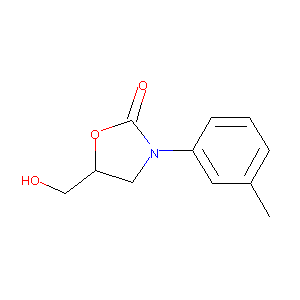Details of the Drug
General Information of Drug (ID: DMHV5NK)
| Drug Name |
TOLOXATONE
|
||||||||||||||||||||||
|---|---|---|---|---|---|---|---|---|---|---|---|---|---|---|---|---|---|---|---|---|---|---|---|
| Synonyms |
Toloxatone; 29218-27-7; Humoryl; Perenum; 5-(Hydroxymethyl)-3-(m-tolyl)oxazolidin-2-one; Toloxatone [INN]; Delalande 69276; Toloxatonum [INN-Latin]; Toloxatona [INN-Spanish]; 5-(Hydroxymethyl)-3-(3-methylphenyl)-2-oxazolidinone; EINECS 249-522-2; BRN 0527506; 69276 MD; CHEMBL18116; 2-oxazolidinone, 5-(hydroxymethyl)-3-(3-methylphenyl)-; 5-Hydroxymethyl-3-(m-tolyl)-2-oxazolidinone; 5-(Hydroxymethyl)-3-m-tolyl-2-oxazolidinone; Toloxatone (INN); 5-(hydroxymethyl)-3-m-tolyloxazolidin-2-one; 2-Oxazolidinone, 5-hydroxymethyl-3-(m-t
|
||||||||||||||||||||||
| Indication |
|
||||||||||||||||||||||
| Drug Type |
Small molecular drug
|
||||||||||||||||||||||
| Structure |
 |
||||||||||||||||||||||
| 3D MOL | 2D MOL | ||||||||||||||||||||||
| #Ro5 Violations (Lipinski): 0 | Molecular Weight (mw) | 207.23 | |||||||||||||||||||||
| Logarithm of the Partition Coefficient (xlogp) | 1.2 | ||||||||||||||||||||||
| Rotatable Bond Count (rotbonds) | 2 | ||||||||||||||||||||||
| Hydrogen Bond Donor Count (hbonddonor) | 1 | ||||||||||||||||||||||
| Hydrogen Bond Acceptor Count (hbondacc) | 3 | ||||||||||||||||||||||
| ADMET Property |
|
||||||||||||||||||||||
| Chemical Identifiers |
|
||||||||||||||||||||||
| Cross-matching ID | |||||||||||||||||||||||
Molecular Interaction Atlas of This Drug
 Drug Therapeutic Target (DTT) |
|
|||||||||||||||||||||||||||||||
|---|---|---|---|---|---|---|---|---|---|---|---|---|---|---|---|---|---|---|---|---|---|---|---|---|---|---|---|---|---|---|---|---|
| Molecular Interaction Atlas (MIA) | ||||||||||||||||||||||||||||||||
Molecular Expression Atlas of This Drug
| The Studied Disease | Discovery agent | |||||||||||||||||||||||||||||
|---|---|---|---|---|---|---|---|---|---|---|---|---|---|---|---|---|---|---|---|---|---|---|---|---|---|---|---|---|---|---|
| ICD Disease Classification | N.A. | |||||||||||||||||||||||||||||
|
||||||||||||||||||||||||||||||
| Molecular Expression Atlas (MEA) | ||||||||||||||||||||||||||||||
References
